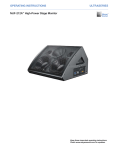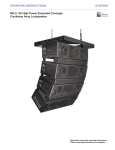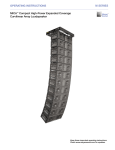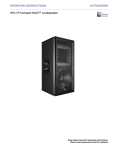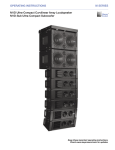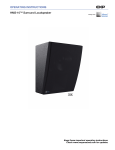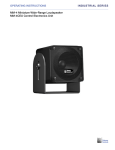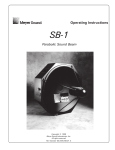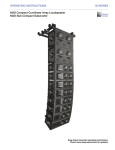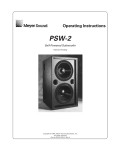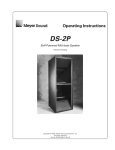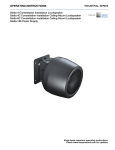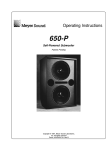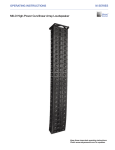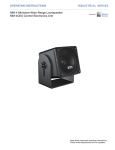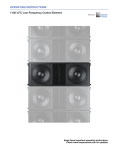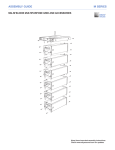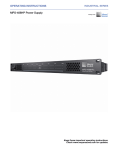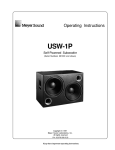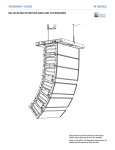Download Meyer Sound MILO Operating instructions
Transcript
OPERATING INSTRUCTIONS ADDENDUM M SERIES MILO 60 High-Power Narrow Coverage Curvilinear Array Loudspeaker Addendum to MILO Operating Instructions (PN 05.132.095.01 A) Keep these important operating instructions. Check www.meyersound.com for updates. DECLARATION OF CONFORMITY ACCORDING TO ISO/IEC GUIDE 22 AND EN 45014 Manufacturer's Name: Meyer Sound Laboratories Inc. Manufacturer's Address: 2832 San Pablo Avenue Berkeley, CA 94702-2204, USA declares that the products Product Name: MILO 60 conforms to the following Product Specifications Safety: EN60065: 1998 IEC60065: 1998 EMC: EN55103-1: 1997 emission1 EN55103-2: 1997 immunity2 This device also complies with EN 55103-1 & -2. Operation is subject to the following two conditions: (1) this device may not cause harmful interference, and (2) this device must accept any interference received, including interference that may cause undesired operation. Supplementary Information The product herewith complies with the requirements of the Low Voltage Directive 73/23/EEC and the EMC Directive 89/336/EEC. Office of Quality Manager Berkeley, California USA January 30, 2005 European Contact: Your local Meyer Sound dealer or Meyer Sound Germany, GmbH. Carl Zeiss Strasse 13, 56751 Polch, Germany. Telephone: 49.2654.9600.58 Fax: 49.2654.9600.59 Environmental specifications for Meyer Sound Electronics products Operating temperature Non-operating temperature Humidity Operating altitude Non-operating altitude Shock Vibration 0°C to +45°C -40°C to +75°C to 95% at 35°C to 4600 m (15,000ft) to 6300 m (25,000ft) 30 g 11 msec half-sine on each of 6 sides 10 Hz to 55 Hz (0.010 peak-to-peak excursion) Made by Meyer Sound Laboratories Berkeley, California USA European Office: Meyer Sound Lab. GmbH Carl Zeiss Strasse 13 56751 Polch, Germany © 2005 Meyer Sound. All rights reserved. Operating Instructions Addendum: MILO 60 High-Power Narrow Coverage Curvilinear Array Loudspeaker The contents of this manual are furnished for informational purposes only, are subject to change without notice, and should not be construed as a commitment by Meyer Sound Laboratories Inc. Meyer Sound assumes no responsibility or liability for any errors or inaccuracies that may appear in this manual. Except as permitted by applicable copyright law, no part of this publication may be reproduced, stored in a retrieval system, or transmitted, in any form or by any means, electronic, mechanical, recording or otherwise, without prior written permission from Meyer Sound. MILO, TruPower, RMS and REM are trademarks of Meyer Sound. Meyer Sound, Meyer Sound MAPP Online, SIM and QuickFly are registered trademarks of Meyer Sound Laboratories Inc. (Reg. U.S. Pat. & Tm. Off.). All third-party trademarks mentioned herein are the property of their respective trademark holders. Printed in the U.S.A. Part Number: 05.132.095.02 A ii SYMBOLS USED These symbols indicate important safety or operating features in this booklet and on the chassis: ! Dangerous voltages: risk of electric shock Important operating instructions Frame or chassis Protective earth ground Pour indiquer les risques résultant de tensions dangereuses Pour indequer important instructions Masse, châssis Terre de protection Zu die gefahren von gefährliche spanning zeigen Zu wichtige betriebsanweisung und unterhaltsanweisung zeigen Rahmen oder chassis Die schutzerde Para indicar voltajes peligrosos. Instrucciones importantes de funcionamiento y/o manteniento Armadura o chassis Tierra proteccionista IMPORTANT SAFETY INSTRUCTIONS 1 Read these instructions. 2. Keep these instructions. 3. Heed all warnings. 4. Follow all instructions. 11. Only use attachments/accessories specified by Meyer Sound. 12. Use only with the caster rails or rigging specified by Meyer Sound, or sold with the loudspeaker. Handles are for carrying only. 5. Do not use this loudspeaker near water. 6. Clean only with dry cloth. 7. Do not block any ventilation openings. Install in accordance with Meyer Sound’s installation instructions. 8. Do not install near any heat sources such as radiators, heat registers, stoves, or other apparatus that produce heat. 9. Do not defeat the safety purpose of the groundingtype plug. A grounding-type plug has two blades and a third grounding prong. The third prong is provided for your safety. If the provided plug does not fit into your outlet, consult an electrician for replacement of the obsolete outlet. 10. Protect the power cord from being walked on or pinched, particularly at plugs, convenience receptacles, and the point where they exit from the loudspeaker. The AC mains plug or appliance coupler shall remain readily accessible for operation. CAUTION: Rigging should only be done by experienced professionals. 13. Unplug this loudspeaker during lightning storms or when unused for long periods of time. 14. Refer all servicing to qualified service personnel. Servicing is required when the loudspeaker has been damaged in any way, such as when the power-supply cord or plug has been damaged; liquid has been spilled or objects have fallen into the loudspeaker; rain or moisture has entered the loudspeaker; the loudspeaker has been dropped; or when for undetermined reasons the loudspeaker does not operate normally. iii SAFETY SUMMARY English - - - - - - To reduce the risk of electric shock, disconnect the loudspeaker from the AC mains before installing audio cable. Reconnect the power cord only after making all signal connections. Connect the loudspeaker to a two-pole, three-wire grounding mains receptacle. The receptacle must be connected to a fuse or circuit breaker. Connection to any other type of receptacle poses a shock hazard and may violate local electrical codes. Do not install the loudspeaker in wet or humid locations without using weather protection equipment from Meyer Sound. Do not allow water or any foreign object to get inside the loudspeaker. Do not put objects containing liquid on or near the unit. To reduce the risk of overheating the loudspeaker, avoid exposing it to direct sunlight. Do not install the unit near heat-emitting appliances, such as a room heater or stove. This loudspeaker contains potentially hazardous voltages. Do not attempt to disassemble the unit. The unit contains no userserviceable parts. Repairs should be performed only by factorytrained service personnel. - - - Deutsch - - Français - - - iv Pour réduire le risque d’électrocution, débrancher la prise principale de l’hautparleur, avant d’installer le câble d’interface allant à l’audio. Ne rebrancher le bloc d’alimentation qu’après avoir effectué toutes les connections. Branchez l’haut-parleur dans une prise de courant à 3 dérivations (deux pôles et la terre). Cette prise doit être munie d’une protection adéquate (fusible ou coupe-circuit). Le branchement dans tout autre genre de prise pourrait entraîner un risque d’électrocution et peut constituer une infraction à la réglementation locale concernant les installations électriques. Ne pas installer l’haut-parleur dans un endroit où il y a de l’eau ou une humidité excessive. Ne pas laisser de l’eau ou tout objet pénétrer dans l’haut-parleur. Ne pas placer de r´cipients contenant un liquide sur cet appareil, ni à proximité de celui-ci. Pour éviter une surchauffe de l’haut-parleur, conserver-la à l’abri du soleil. Ne pas installer à proximité d’appareils dégageant de la chaleur tels que radiateurs ou appareils de chauffage. Ce haut-parleur contient des circuits haute tension présentant un danger. Ne jamais essayer de le démonter. Il n’y a aucun composant qui puisse être réparé par l’utilisateur. Toutes les réparations doivent être effectuées par du personnel qualifié et agréé par le constructeur. - - - Um die Gefahr eines elektrischen Schlages auf ein Minimum zu reduzieren, den Lautsprecher vom Stromnetz trennen, bevor ggf. ein Audio-Schnittstellensign alkabel angeschlossen wird. Das Netzkabel erst nach Herstellung aller Signalverbindungen wieder einstecken. Der Lautsprecher an eine geerdete zweipolige DreiphasenNetzsteckdose anschließen. Die Steckdose muß mit einem geeigneten Abzweigschutz (Sicherung oder Leistungsschalter) verbunden sein. Der Anschluß der unterbrechungsfreien Stromversorgung an einen anderen Steckdosentyp kann zu Stromschlägen führen und gegen die örtlichen Vorschriften verstoßen. Der Lautsprecher nicht an einem Ort aufstellen, an dem sie mit Wasser oder übermäßig hoher Luftfeuchtigkeit in Berührung kommen könnte. Darauf achten, daß weder Wasser noch Fremdkörper in das Innere den Lautsprecher eindringen. Keine Objekte, die Flüssigkeit enthalten, auf oder neben die unterbrechungsfreie Stromversorgung stellen. Um ein Überhitzen dem Lautsprecher zu verhindern, das Gerät vor direkter Sonneneinstrahlung fernhalten und nicht in der Nähe von wärmeabstrahlenden - Haushaltsgeräten (z.B. Heizgerät oder Herd) aufstellen. Im Inneren diesem Lautsprecher herr-schen potentiell gefährliche Spannungen. Nicht versuchen, das Gerät zu öffnen. Es enthält keine vom Benutzer reparierbaren Teile. Reparaturen dürfen nur von ausgebildetem Kundenienstpersonal durchgeführt werden. Español - - - - - Para reducir el riesgo de descarga eléctrica, desconecte de la red de voltaje el altoparlante antes de instalar el cable de señal de audio. Vuelva a conectar la alimentacion de voltaje una vez efectuadas todas las interconexiones de señalizacion de audio. Conecte el altoparlante a un tomacorriente bipolar y trifilar con neutro de puesta a tierra. El tomacorriente debe estar conectado a la protección de derivación apropiada (ya sea un fusible o un disyuntor). La conexión a cualquier otro tipo de tomacorriente puede constituir peligro de descarga eléctrica y violar los códigos eléctricos locales. No instale el altoparlante en lugares donde haya agua o humedad excesiva. No deje que en el altoparlante entre agua ni ningún objeto extraño. No ponga objetos con líquidos encima de la unidad ni cerca de ella. Para reducir el riesgo de sobrecalentamiento, no exponga la unidad a los rayos directos del sol ni la instale cerca de artefactos que emiten calor, como estufas o cocinas. Este altoparlante contiene niveles de voltaje peligrosos en potencia. No intente desarmar la unidad, pues no contiene piezas que puedan ser repardas por el usuario. Las reparaciones deben efectuarse únicamente por parte del personal de mantenimiento capacitado en la fábrica. Operating Instructions Addendum: MILO 60 MILO™ 60 HIGH-POWER NARROW COVERAGE CURVILINEAR ARRAY INTRODUCING THE MILO 60 A variation on the popular MILO high-power curvilinear loudspeaker, the MILO 60 high-power narrow coverage curvilinear array loudspeaker excels where controlled narrow horizontal coverage is needed. The self-powered MILO 60 (Figure 1) is a compact, lightweight four-way system that provides 60 degrees of horizontal coverage, and vertical coverage matching the original MILO (nominally 10 degrees in the high-frequency and very-high-frequency sections; vertical coverage across all frequency bands within a line array varies, depending on the length and configuration of the array). The coverage pattern is optimized for applications requiring tight horizontal coverage, such as at the top in mixed arrays with standard MILO line array loudspeaker systems, or for sidefill systems to extend horizontal coverage. Figure 1. The MILO 60 high-power narrow coverage curvilinear array loudspeaker The MILO 60 loudspeaker produces a peak output of 140 dB SPL with exceptionally flat phase and frequency response. Its wide operating frequency range (60 Hz to 18 kHz) is complemented by extended high-frequency headroom and a dedicated very-high-frequency section (4.2 kHz to 18 kHz) that renders delicate transient information with detailed resolution through its coverage pattern. The driver complement is identical to that of MILO, with the compression drivers in the high- and very-high-frequency sections going through patented REM™ ribbon emulation manifolds into custom 60-degree constant-directivity horns. Control electronics are designed to maintain flat frequency and phase response throughout the loudspeaker’s coverage pattern. The MILO 60 loudspeaker’s acoustical characteristics are designed to facilitate seamless integration when used with other MILO curvilinear array elements. As with all MILO loudspeakers, the MILO 60 comes standard with integrated amplification, RMS™ remote monitoring system, TruPower® limiting system, and AlignaLink hardware for use with the MILO QuickFly® rigging hardware. NOTE: For more detail about these features, plus information on the SIM® source independent measurement system and the Meyer Sound MAPP Online® acoustical prediction program, please see the MILO High-Power Curvilinear Array Loudspeaker Operating Instructions (Part Number 05.132.095.01). MILO 60 DRIVER INTERCONNECTIONS The MILO 60 uses the same 4-channel amplifier as the standard MILO loudspeaker, and the low-frequency control card is the same. The upper control card for the high-frequency and very-high-frequency sections is specific to the MILO 60. Each front 4-ohm, 12-inch, low-frequency cone driver is powered by one 1125-watt channel of the HP-4/MILO amplifier. The single 4-inch diaphragm, 8-ohm high-frequency compression driver is powered by a single 560-watt channel and the three 2-inch diaphragm, 12-ohm very-high-frequency compression drivers share the fourth 1125-watt channel. The following diagram shows how the drivers are connected to the amplifier. Very High Mid-High 60 Figure 2. MILO 60 internal wiring harness diagram 1 Operating Instructions Addendum: MILO 60 FLYING AND ARRAYING THE MILO 60 Standalone MILO 60 Arrays The MILO 60 loudspeaker shares the same dimensions and rigging components as the MILO to facilitate seamless integration, and uses the MG-3D/M multipurpose grid for flying. Since the MILO 60 is identical in size to the MILO, all of the standard MILO QuickFly hardware may be used. Each cabinet is fitted with the MRF-MILO rigging frame for use with AlignaLinks that attach to the front and rear of the cabinets for splaying them when flown or stacked. The hardware allows adjustments of cabinet splay in nine steps between 0 and 5 degrees — in 0.5-degree increments up to 3 degrees, and in 1-degree increments between 3 and 5 degrees. Arrays can be built using only MILO 60 loudspeakers, creating a sound source with a 60-degree horizontal coverage. This type of array is especially useful when narrow coverage is required. The MG-3D/M multipurpose grid is used for both flying and ground support for the MILO loudspeaker arrays. The MLK-MILO link kit is required to connect any MILO cabinet to the multipurpose grid. A variety of transition hardware allows MILO cabinets to be used in arrays with other M Series cabinets such as the M3D, M3D-Sub, and M2D. Please see the M Series section of the QuickFly Overview brochure (Part Number 18.990.126.02 D) for an overview of these products, and the MG-3D/M Assembly Guide (Part Number 05.132.036.01) for details on the installation and applications of flying hardware for Meyer Sound loudspeaker systems. CAUTION: All Meyer Sound products must be used in accordance with local, state, federal and industry regulations. It is the owner’s and/or user’s responsibility to evaluate the reliability of any rigging method for their application. Rigging should be carried out only by experienced professionals. CAUTION: Always use properly rated rigging hardware. CAUTION: It is important to inspect rigging hardware regularly and replace worn or damaged components immediately. 2 Typical applications would be as audience side-fill loudspeakers to complement the front-facing main arrays in a wider venue or stadium, as main reinforcement array(s) for narrow venues, or for precise 60-degree sectioning of a centrally mounted array. Integrating MILO 60 with MILO Arrays The various coverage angles available with the MILO family of loudspeakers may be used to optimize the overall coverage of venues, assuring that all members of the audience receive consistent sound — with as uniform frequency response and SPL as possible. The standard MILO cabinets with their 90-degree horizontal coverage may be supplemented with the extended coverage MILO 120 cabinets at the bottom of the array to provide fill to the audience nearer to the stage. MILO 60 cabinets would most often be used toward the top of the array to provide coverage for the higher, more distant balconies. NOTE: For more information on line array design and integration please refer to Chapter 4 of the MILO High-Power Curvilinear Array Loudspeaker Operating Instructions. NOTE: Since MILO 120 expanded coverage high-power curvilinear array loudspeakers make use of custom AlignaLinks, please see details on how to use this rigging in Chapter 7 of the MILO 120 Operating Instructions (Part Number: 05.142.003.01 A). Operating Instructions Addendum: MILO 60 Figure 3. Example configuration: combined MILO 60 (top three cabinets) and MILO array Figure 4. Example configuration: combined MILO 60 (top), MILO, and MILO 120 (bottom) array 3 Operating Instructions Addendum: MILO 60 USING SUBWOOFERS WITH THE MILO 60 MILO 60 with the M3D-Sub A MILO 60 system (or combined MILO 60/MILO/MILO 120 system) will provide full bandwidth frequency response down to 60 Hz. The height of the array (number of cabinets) will determine the total SPL available and how much low frequency energy can be provided, proportional to the upper-frequency spectrum. The M3D-Sub directional subwoofer adds substantial lowfrequency headroom to MILO curvilinear arrays, extending the system frequency response to 30 Hz. If higher SPL is necessary, or the program content requires additional low-frequency energy (e.g., the reinforcement of popular music), then subwoofers should be used to augment your MILO curvilinear array. The M3D-Sub has advantages over other subwoofers due to its unique low-frequency directional control and its ability to be vertically arrayed with MILO since they share the same width. NOTE: For most applications, you want to keep low frequencies from being produced behind the array to reduce or eliminate the low frequency reverberant noise traditionally associated with large-scale, full-range loudspeaker arrays. The M3D-Sub’s award-winning and patent-pending cardioid directional pattern provides maximum lowfrequency attenuation from 6 to 12 meters behind the cabinet (-20 dB at 8 meters). Meyer Sound subwoofers, such as the M3D-Sub and 700-HP, can achieve frequency response down in the 30 Hz range, extending the system response appreciably and increasing the acoustic power of the system in the lowest frequencies. In addition, the use of high-pass filters to drive a MILO system with subwoofers increases the headroom of the array in the lowest end of its usable spectrum. The ideal ratio of MILO loudspeakers to subwoofers depends on the configuration of the array and the frequency content of the signal being reproduced by the system. For most applications, two MILO loudspeakers for each subwoofer yields good results in frequency response and headroom. NOTE: The limit LEDs indicate when the safe power level is exceeded. If the subwoofers used in the system begin to limit before reaching the required SPL at low frequencies, consider adding more subwoofers to satisfy the SPL requirements without exposing the drivers to excessive heat and/ or excursion. Table 1 shows how you can integrate MILO (or combined MILO 60/MILO/MILO 120) arrays with the M3D-Sub subwoofer using the LD-3 line driver’s filtering capabilities to fine-tune the system. All the data in Table 1 is based on system designs with a 2:1 ratio and in a close-proximity, coplanar orientation. When loudspeakers and subwoofers are physically separated by more than 4 feet — or delay must be used between them — a measurement system such as the SIM audio analyzer (covered in Chapter 5 of the MILO Operating Instructions) should be used to determine the correct delay and polarity. Table 1. MILO 60/MILO/MILO 120 and M3D-Sub Using the LD-3 compensating line driver’s filters helps to easily integrate and optimize your MILO arrays with subwoofers. The use of high-pass filters augments array headroom by removing lower frequencies near the unit’s lower operating range, while low-pass filters can remove unwanted mid-low frequencies reproduced by the subwoofers. The use of these filters reduces the area of overlap and minimizes the interaction and possible cancellations between subsystems. NOTE: Full-range signals may be applied to Meyer Sound’s self-powered loudspeakers and subwoofers because they have built-in active crossovers. However, the use of external filters — like the ones in the LD-3 line driver — is optional, and should be used very carefully to minimize phase shifts that can cause cancellations. 4 HPF LPF ø Reverse Result Switch 80 80 Engaged Flat response 80 Off Engaged Flat response 160 Off Engaged Very flat response Off Off Off Boost in the 80 Hz region Operating Instructions Addendum: MILO 60 MILO 60 with the 700-HP Subwoofer In applications where M3D-Sub features like directional low-frequency control are not needed, a MILO 60 array can be deployed in combination with Meyer Sound 700HP subwoofers. The 700-HP subwoofer extends the MILO system frequency response down to 30 Hz. Table 2 shows how you can integrate MILO (or combined MILO 60/MILO/MILO 120) arrays with 700-HP using the LD-3 line driver’s filtering capabilities to fine-tune the system. All data in Table 2 is based on system designs with a 2:1 ratio and in a close-proximity, coplanar orientation. When loudspeakers and subwoofers are physically separated by more than 4 feet – or delay must be used between them – a measurement system such as SIM should be used to determine the correct delay and polarity. Table 2. MILO 60/MILO/MILO 120 and 700-HP Subwoofer HPF LPF ø Reverse Additional information on the LD-3 can be found in the LD-3 Compensating Line Driver Operating Instructions (Part Number 05.118.040.01 B). Figure 5. LD-3 compensating line driver, front panel USING THE RMS REMOTE MONITORING SYSTEM WITH THE MILO 60 Meyer Sound’s RMS remote monitoring system is fitted as standard, providing comprehensive monitoring of system performance parameters over a Windows®-based network. For details, please see Chapter 3 of the MILO Operating Instructions. Result Switch Off Off Engaged Boost in the 100 Hz region 160 Off Engaged Very flat response 80 80 Off Very flat response 160 80 Off Flat response LD-3 LINE DRIVER SETTINGS FOR THE MILO 60 LD-3 Array Correction The LD-3 line driver’s array correction filters are used to compensate for the low and low-mid frequency buildup that occurs in all line arrays. Because the low and mid-low sections of all MILO systems are identical, set the Array Type to MILO and set the Array Size to match the total number of loudspeakers in the array; this is true of reinforcement systems consisting of the MILO 60 by itself or in combination with other MILO loudspeakers. Figure 6. MILO 60 loudspeaker icon in RMS page USING MAPP ONLINE™ FOR SYSTEM DESIGNS INCLUDING THE MILO 60 The MAPP Online acoustical prediction program is a powerful, cross-platform, Java-based application for accurately predicting the coverage pattern, frequency response, impulse response and maximum SPL output of single or arrayed Meyer Sound loudspeakers. Coverage data for the MILO 60 cabinet is included in the MAPP Online database. Detailed information on the use and application of MAPP Online can be found in the MILO Operating Instructions at the end of the “Line Arrays and System Integration" section. MAPP Online can be accessed through the Meyer Sound Web site at: www.meyersound.com. LD-3 Atmospheric Correction Use the Atmospheric Correction section of the LD-3 to compensate for the air attenuation effects on higher frequencies, which are especially noticeable in longer-throw applications (typical of a stadium, an outdoor shed, and other larger events). Enter the altitude plus the temperature and humidity conditions at the venue, and then set the distance from the array to the listeners to introduce the correction. With the use of the individual distance settings available on each of the outputs of the LD-3, the line array can be divided into up to three sections to correspond to the loudspeaker-to-audience distance for the near, medium and long-throw sections of the array. WEATHER PROTECTION OPTIONS A weather-protected version with a folding rain hood that safeguards the electronics is optionally available. See Appendix A within the MILO Operating Instructions for details on how to deploy the rain hood. 5 Operating Instructions Addendum: MILO 60 6 Operating Instructions Addendum: MILO 60 APPENDIX A: MILO 60 SPECIFICATIONS ACOUSTICAL Note: The low-frequency power response of the system will increase according to the length of the array. Operating frequency range 60 Hz - 18 kHz Note: Recommended maximum operating frequency range. Response depends upon loading conditions and room acoustics. Free field frequency response 65 Hz - 17.5 kHz ±4 dB Phase response 750 Hz - 16 kHz ±30° Maximum peak SPL 140 dB Note: Measured with 1/3-octave frequency resolution at 4 meters. Note: Measured with music at 1 meter. Dynamic range >110 dB Horizontal coverage 60° Vertical coverage Varies, depending on array length and configuration Acoustical crossover 560 Hz, 4.2 kHz Note: At these frequencies, the transducers produce equal sound pressure levels: 560 Hz for the low-mid and mid-high and 4.2 kHz for the mid-high and very-high frequency drivers. TRANSDUCERS Low/low-mid frequency Two 12" cone drivers with neodymium magnets Nominal impedance: 4 Ω Voice coil size: 4" Power-handling capability: 1200 W (AES) Note: Power handling is measured under AES standard conditions: transducer driven continuously for two hours with band limited noise signal having a 6 dB peak-average ratio. Note: To eliminate interference at short wavelengths, the two 12-inch drivers work in combination at low frequencies (60 Hz – 300 Hz). At mid frequencies (300 Hz – 560 Hz) only one cone driver is fed from the crossover to maintain optimal polar and frequency response characteristics. Mid-high frequency One 4" compression driver Nominal impedance: 8 Ω Voice coil size: 4" Diaphragm size: 4" Exit size: 1.5" Power handling capability: 250 W (AES) on REM Note: Power handling is measured under AES standard conditions: transducer driven continuously for two hours with band limited noise signal having a 6 dB peak-average ratio. Note: The driver is coupled to a 60-degree-horizontal constant-directivity horn through a proprietary acoustical combining manifold (REM). Very-high frequency Three 2" compression drivers Nominal impedance: 12 Ω Voice coil size: 2" Diaphragm size: 2" Exit size: 0.75" Power handling capability: 100 W (AES) on REM Note: Power handling is measured under AES standard conditions: transducer driven continuously for two hours with band limited noise signal having a 6 dB peak-average ratio. Note: The three drivers are coupled to a 60-degree-horizontal constant-directivity horn through a proprietary acoustical combining manifold (REM). 7 Operating Instructions Addendum: MILO 60 AUDIO INPUT Type Differential, electronically balanced Max. common mode range ±15 V DC, clamped to earth for voltage transient protection Connectors Female XLR input with male XLR loop output or VEAM Input impedance 10 kΩ differential between pins 2 and 3 Wiring Pin 1: Chassis/earth through 220 kΩ, 1000 pF, 15 V clamp network to provide virtual ground lift at audio frequencies Pin 2: Signal + Pin 3: Signal Case: Earth ground and chassis DC Blocking None on input, DC blocked through signal processing CMRR >50 dB, typically 80 dB (50 Hz – 500 Hz) RF filter Common mode: 425 kHz Differential mode: 142 kHz TIM filter <80 kHz, integral to signal processing Nominal input sensitivity 0 dB V (1 V rms, 1.4 V pk) continuous is typically the onset of TPL limiting for noise and music. Input level Audio source must be capable of producing a minimum of +20 dBV (10 V rms, 14 V pk) into 600 Ω in order to produce maximum peak SPL over the operating bandwidth of the loudspeaker AMPLIFIERS Amplifier type Output power Complementary power MOSFET output stages (class AB/H) 3935 W (four channels; 3 x 1125 W, 1 x 560 W) Note: Amplifier wattage rating is based on the maximum unclipped burst sine-wave rms voltage the amplifier will produce in to the nominal load impedance low, mid and very high channels 67 V rms (95 V pk) into 4 ohms; mid-high channel 67 V rms (95 V pk) into 8 ohms. THD, IM TIM < .02% Load capacity 4 Ω low, low-mid and very-high channels; 8 Ω mid-high channel Cooling Forced air cooling, 4 fans total (2 ultra-high-speed reserve fans) AC POWER AC power connector 250 V AC NEMA L6-20 (twistlock) inlet, IEC 309 male inlet, or VEAM all-in-one connector (integrates AC, audio and network) Voltage selection Automatic, two ranges, each with high-low voltage tap (uninterrupted) Safety agency rated operating voltage 95 V AC – 125 V AC, 208 V AC - 235 V AC, 50/60 Hz Turn on/turn off points 85 V AC – 134 V AC; 165 V AC - 264 V AC Current Draw Idle current 1.1 A rms (115 V AC), 0.55 A rms (230 V AC), 1.3 A rms (100 V AC) Max. long-term continuous current (>10 sec) 11.2 A rms (115 V AC), 5.6 A rms (230 V AC), 12.9 A rms (100 V AC) Burst Current (<1 sec) 14.4 A rms (115 V AC), 7.2 A rms (230 V AC), 16.6 A rms (100 V AC) Note: AC power cabling must be of sufficient gauge so that under burst current rms conditions, cable transmission losses do not drop voltage below specified operating range at the speaker. Ultimate Short-Term Peak Current Draw 32 A rms (115 V AC), 16 A rms (230 V AC), 37 A rms (100 V AC) Inrush Current 7 A rms (115 and 110 V AC), 10 A rms (230 V AC) RMS NETWORK Equipped for two conductor twisted-pair network, reporting all operating parameters of amplifiers to system operator’s host computer. 8 Operating Instructions Addendum: MILO 60 PHYSICAL: MILO 120 Loudspeaker Enclosure Multi-ply hardwood Finish Black textured Protective grille Powder-coated hex stamped steel Rigging QuickFly MRF-MILO rigging frame, custom AlignaLink connectors and quick release pins Dimensions 54.00" w x 14.47" h x 22.00" d (1372 mm x 368 mm x 559 mm) Weight 235 lbs (106.60 kg) � � � � � � � � � � 9 Operating Instructions Addendum: MILO 60 10 Meyer Sound Laboratories Inc. 2832 San Pablo Avenue Berkeley, CA 94702 www.meyersound.com T: +1 510 486.1166 F: +1 510 486.8356 © 2005 Meyer Sound Laboratories Inc. 05.132.095.02 A
















